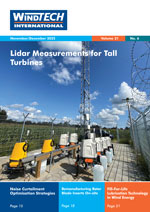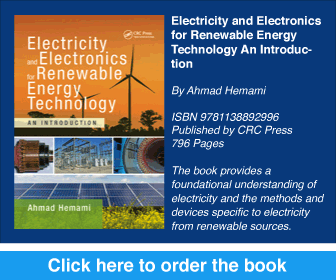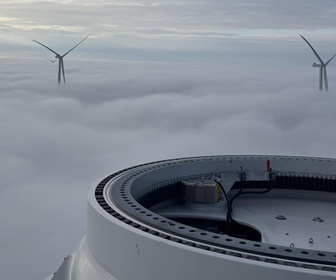- Category: Articles
Simulation with the New Simulation Code SiWEC
For many years most modern large wind turbines were erected in areas like Denmark and northern Germany, where earthquakes are rare and normally weak. However, more recently wind farms have been developed in Asia, Africa and southern Europe, where strong earthquakes are much more likely to occur. As a consequence, the question arises as to how wind turbines perform in an earthquake of a given magnitude, and especially to what extent the stability of the overall structure and integrity of the machinery are guaranteed. This article describes how building codes for seismic loading of structures are used for site approvals for wind farms and shows results for the simulated dynamical behaviour of a wind turbine in an earthquake. The simulation has been carried out with the new simulation code SiWEC, which is also introduced in this article.
By M. Hänler, U. Ritschel and I. Warnke, Windrad Engineering GmbH, Germany
- Category: Articles
Tethered Wing Design for the Laddermill Project
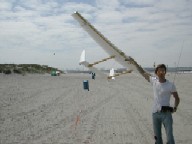 Imagine a kite that looks like an aircraft and can be flown like one. An efficient, reliable and stable design. Such a kite is a portable pulling force in the air. With this force it is possible to do all kinds of exciting things such as pull ships and generate energy. At the Delft University of Technology, Faculty of Aerospace Engineering, kites are maturing from ‘toys’ to a serious force to be reckoned with.
Imagine a kite that looks like an aircraft and can be flown like one. An efficient, reliable and stable design. Such a kite is a portable pulling force in the air. With this force it is possible to do all kinds of exciting things such as pull ships and generate energy. At the Delft University of Technology, Faculty of Aerospace Engineering, kites are maturing from ‘toys’ to a serious force to be reckoned with.By Jeroen Breukels, PhD student, and Prof. Dr Wubbo J. Ockels, Chair ASSET, TU-Delft, The Netherlands
- Category: Articles
Bachmann electronic’s M1 Control System
 The operation of modern and increasingly high-capacity wind energy installations makes many demands on automation technology. Modern pitch-controlled systems, which satisfy requirements of more precise and controlled power output in practically all wind and plant configurations, need relatively complex active control systems that can no longer be supplied by a simple programmable logic controller (PLC). In addition, increasingly common and urgent demands from network operators to correct frequency or reactive power fluctuations in the whole park call for previously unknown communication abilities. In this article, Bachmann electronic describe the capabilities of their new M1 control system, which was designed to meet these demands.
The operation of modern and increasingly high-capacity wind energy installations makes many demands on automation technology. Modern pitch-controlled systems, which satisfy requirements of more precise and controlled power output in practically all wind and plant configurations, need relatively complex active control systems that can no longer be supplied by a simple programmable logic controller (PLC). In addition, increasingly common and urgent demands from network operators to correct frequency or reactive power fluctuations in the whole park call for previously unknown communication abilities. In this article, Bachmann electronic describe the capabilities of their new M1 control system, which was designed to meet these demands.By Gabriel Schwanzer, Director Sales and Automation, Bachmann electronic, Austria
- Category: Articles
Setting the Framework for the Sahara Wind Energy Development Project
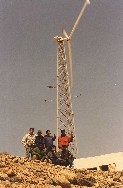 The wind energy industry was initially encouraged to provide employment in the relatively poor North Sea regions of Germany. In the last 10 years, however, it has emerged as a major business providing most competitive prices of electricity even when operated under marginal European wind conditions. The trade winds that blow along the Atlantic coast from Morocco to Senegal represent the largest and most productive wind potentials available on Earth. Because of the erratic nature of winds, however, wind energy cannot be integrated locally on any significant scale unless far-ranging, more advanced energy technologies are considered. The Sahara Wind Energy Development Project is looking at ways in which these large trade wind resources could be used to benefit both North Africa and Europe.
The wind energy industry was initially encouraged to provide employment in the relatively poor North Sea regions of Germany. In the last 10 years, however, it has emerged as a major business providing most competitive prices of electricity even when operated under marginal European wind conditions. The trade winds that blow along the Atlantic coast from Morocco to Senegal represent the largest and most productive wind potentials available on Earth. Because of the erratic nature of winds, however, wind energy cannot be integrated locally on any significant scale unless far-ranging, more advanced energy technologies are considered. The Sahara Wind Energy Development Project is looking at ways in which these large trade wind resources could be used to benefit both North Africa and Europe.
By Khalid Benhamou, Sahara Wind Inc., Morocco
.
 The wind energy industry was initially encouraged to provide employment in the relatively poor North Sea regions of Germany. In the last 10 years, however, it has emerged as a major business providing most competitive prices of electricity even when operated under marginal European wind conditions. The trade winds that blow along the Atlantic coast from Morocco to Senegal represent the largest and most productive wind potentials available on Earth. Because of the erratic nature of winds, however, wind energy cannot be integrated locally on any significant scale unless far-ranging, more advanced energy technologies are considered. The Sahara Wind Energy Development Project is looking at ways in which these large trade wind resources could be used to benefit both North Africa and Europe.
The wind energy industry was initially encouraged to provide employment in the relatively poor North Sea regions of Germany. In the last 10 years, however, it has emerged as a major business providing most competitive prices of electricity even when operated under marginal European wind conditions. The trade winds that blow along the Atlantic coast from Morocco to Senegal represent the largest and most productive wind potentials available on Earth. Because of the erratic nature of winds, however, wind energy cannot be integrated locally on any significant scale unless far-ranging, more advanced energy technologies are considered. The Sahara Wind Energy Development Project is looking at ways in which these large trade wind resources could be used to benefit both North Africa and Europe.By Khalid Benhamou, Sahara Wind Inc., Morocco
- Category: Articles
Energy Storage as a Matter of Urgency
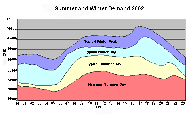 As the penetration of wind power increases in the UK, the issue of the unpredictability of wind power could create problems for electricity traders and network balancing mechanisms. Market penetration is currently less than 2%, but traders are already discounting wind-generated power. If no mitigation is implemented, this situation could worsen as market penetration increases towards the goal of 15% renewables by 2015. The solution may be to use electrolysis of water to create hydrogen fuel, with the electrolysis operation being determined by the needs of the electricity networks.
As the penetration of wind power increases in the UK, the issue of the unpredictability of wind power could create problems for electricity traders and network balancing mechanisms. Market penetration is currently less than 2%, but traders are already discounting wind-generated power. If no mitigation is implemented, this situation could worsen as market penetration increases towards the goal of 15% renewables by 2015. The solution may be to use electrolysis of water to create hydrogen fuel, with the electrolysis operation being determined by the needs of the electricity networks.
 As the penetration of wind power increases in the UK, the issue of the unpredictability of wind power could create problems for electricity traders and network balancing mechanisms. Market penetration is currently less than 2%, but traders are already discounting wind-generated power. If no mitigation is implemented, this situation could worsen as market penetration increases towards the goal of 15% renewables by 2015. The solution may be to use electrolysis of water to create hydrogen fuel, with the electrolysis operation being determined by the needs of the electricity networks.
As the penetration of wind power increases in the UK, the issue of the unpredictability of wind power could create problems for electricity traders and network balancing mechanisms. Market penetration is currently less than 2%, but traders are already discounting wind-generated power. If no mitigation is implemented, this situation could worsen as market penetration increases towards the goal of 15% renewables by 2015. The solution may be to use electrolysis of water to create hydrogen fuel, with the electrolysis operation being determined by the needs of the electricity networks.By Declan Pritchard, Wind Hydrogen Limited, UK
- Category: Articles
What is the Best Way to Assess This?
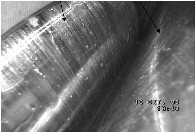 Turbine damage is still an everyday reality in the lifetime of a wind park. Owners are frustrated by repeated gearbox failures or blade repairs. In order to minimise failure rates and downtime it is becoming increasingly common to use independent assessors to check the status of the whole turbine or of certain critical parts like the gearbox or main bearings.
Turbine damage is still an everyday reality in the lifetime of a wind park. Owners are frustrated by repeated gearbox failures or blade repairs. In order to minimise failure rates and downtime it is becoming increasingly common to use independent assessors to check the status of the whole turbine or of certain critical parts like the gearbox or main bearings.By Jürgen Holzmüller, Dietmar Obst, Jochen Ziehmann and Rüdiger Kipke, 8.2, Germany
- Brakes in Modern Wind Turbines
- A Fresh Breeze for Gears
- GyroTorque, Continuously Variable Transmission (GTCVT)
- Cost of Lost Production
- The Sound of an Endless Train
- SmartEnergy Spire
- A Motion Compensated Platform for Wind Turbine Maintenance
- Zephyr’s ‘Airdolphin’
- Increased Performance by Condition Monitoring of Rotor Blades
- Offshore Winds Observed from Space
- Improving Wind Energy’s Market Penetration
- Measurement at 80 Metres with a New Design Wind Mast
- Turbine Shortages and Rising Costs Stall Development
- Aerodynamic Damping
- Sharing the Sea
- Offshore Wind Farm Layout Optimisation
- New BAUER Flydrill system
- Investigation of Stability Effects of an Offshore Wind Turbine
- AeroBlade
- Geotechnical Analysis Requirements
- Electric Vehicles with V2G
- The Benefits of Cooperation
- The Atmospheric Vortex Engine
- Acoustical Behaviour of a Wind Turbine
- Railwind Turbine
- Computational Fluid Dynamics
- Damage to wind turbines from typhoons
- Deep Offshore Wind Farms
- Economics of Intermittent Wind Generation
- The Aeolus Project



